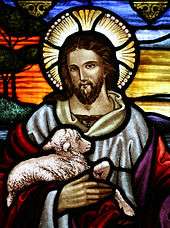The New Commandment

The New Commandment of Jesus to "love one another" is part of the final instructions given to his disciples after the Last Supper had ended,[1] and after Judas Iscariot had departed in John 13:30.[2][3][4]
Little children, yet a little while I am with you. Ye shall seek me: and as I said unto the Jews, Whither I go, ye cannot come; so now I say to you. 34 A new commandment I give unto you, That ye love one another; as I have loved you, that ye also love one another. 35 By this shall all men know that ye are my disciples, if ye have love one to another. —John 13:33-35 (KJV)
This commandment appears thirteen times in twelve verses in the New Testament.[4][5] Theologically, this commandment is interpreted as dual to the Love of Christ for his followers.[2] The commandment can also be seen as the last wish in the Farewell Discourse to the disciples.[6]
Despite the name, the commandment is not technically "new". The commandment to love one another is found in Leviticus 19 18.
You shall not take vengeance or bear a grudge against your kinsfolk. Love your neighbor as yourself: I am the LORD.
Gospel of John
The statement of the new commandment by Jesus in John 13:34-35 was after the Last Supper, and after the departure of Judas.[8] The commandment was prefaced in John 13:33 by Jesus telling his remaining disciples, as little children, that he will be with them for only a short time, then will leave them.[8]
In the commandment Jesus told the disciples: "Love one another; as I have loved you".[2][9]
Just after the commandment, and before the Farewell Discourse the first reference to Peter's Denials took place, where Jesus predicted that Peter would deny him three times before the cock crow.[8]
Two similar statements also appear in chapter 15 of the Gospel of John:[3]
- John 15:12: This is my commandment, that ye love one another, even as I have loved you.
- John 15:17: These things I command you, that ye may love one another.
Other New Testament references
Johannine writings
The Johannine writings include other, similar passages.[3][4]
- 1 John 3:11: For this is the message which ye heard from the beginning, that we should love one another
- 1 John 3:23: And this is his commandment, that we should believe in the name of his Son Jesus Christ, and love one another, even as he gave us commandment.
- 1 John 4:7: let us love one another: for love is of God;
- 1 John 4:12: No man hath beheld God at any time: if we love one another, God abideth in us, and his love is perfected in us.
Similarly, the Second Epistle of John states:[4]
- 2 John 5: not as though I wrote to thee a new commandment, but that which we had from the beginning, that we love one another.
Pauline letters
The Pauline Epistles also contain similar references.[4]
- Romans 13:8: Owe no man anything, save to love one another: for he that loveth his neighbor hath fulfilled the law.
- 1 Thessalonians 4:9: ... for ye yourselves are taught of God to love one another.
1 Peter
The First Epistle of Peter has a similar statement:[4]
- 1 Peter 1:22: ... for ye yourselves are taught of God to love one another.
Interpretations
The "New Commandment", the Wycliffe Bible Commentary states, "was new in that the love was to be exercised toward others not because they belonged to the same nation, but because they belonged to Christ...and the love of Christ which the disciples had seen...would be a testimony to the world".[10]
One of the novelties introduced by this commandment – perhaps justifying its designation as New – is that Jesus "introduces himself as a standard for love".[11] The usual criterion had been "as you love yourself". However, the New Commandmant goes beyond "as you love yourself" as found in the ethic of reciprocity and states "as I have loved you", using the Love of Christ for his disciples as the new model.[11]
The First Epistle of John reflects the theme of love being an imitation of Christ, with 1 John 4:19 stating: "We love, because he first loved us."[12]
See also
References
- ↑ John 13:2 "And supper being ended...",
- 1 2 3 The Gospel of John (1998) by Francis J. Moloney and Daniel J. Harrington. ISBN 0-8146-5806-7. Page 425.
- 1 2 3 Yarbrough, Robert W. (2008). 1, 2, and 3 John. Baker Academic. p. 100. ISBN 0801026873. Retrieved July 5, 2012.
- 1 2 3 4 5 6 Wiersbe, Warren W. (1992). The Bible Exposition Commentary. p. 487. ISBN 1564760316. Retrieved July 5, 2012.
- ↑ John.13:34;15:12;15:17
- ↑ Imitating Jesus by Richard A. Burridge 2007 ISBN 0802844588 page 301
- ↑ New JPS Hebrew/English Tanakh
- 1 2 3 Encountering John: The Gospel in Historical, Literary, and Theological Perspective by Andreas J. Kostenberger 2002 ISBN 0801026032 pages 149-151
- ↑ The Gospel of John (1994) by Frederick Bruce. ISBN 0-8028-0883-2. Page 294.
- ↑ Charles F. Pfeiffer and Everett F. Harrison, eds. (1971). The Wycliffe Bible Commentary. New York: Iversen-Norman Associates. p. 341. LCCN 72-183345.
- 1 2 "Homily of Cardinal Martins, Antequera, Spain". The Vatican. 2007-05-06. Retrieved 2008-08-26.
- ↑ The People's New Testament Commentary by M. Eugene Boring and Fred B. Craddock 2010 ISBN 0664235921 page 335
| |||||||||||||||||||||||||||||||||||||||||||||||
